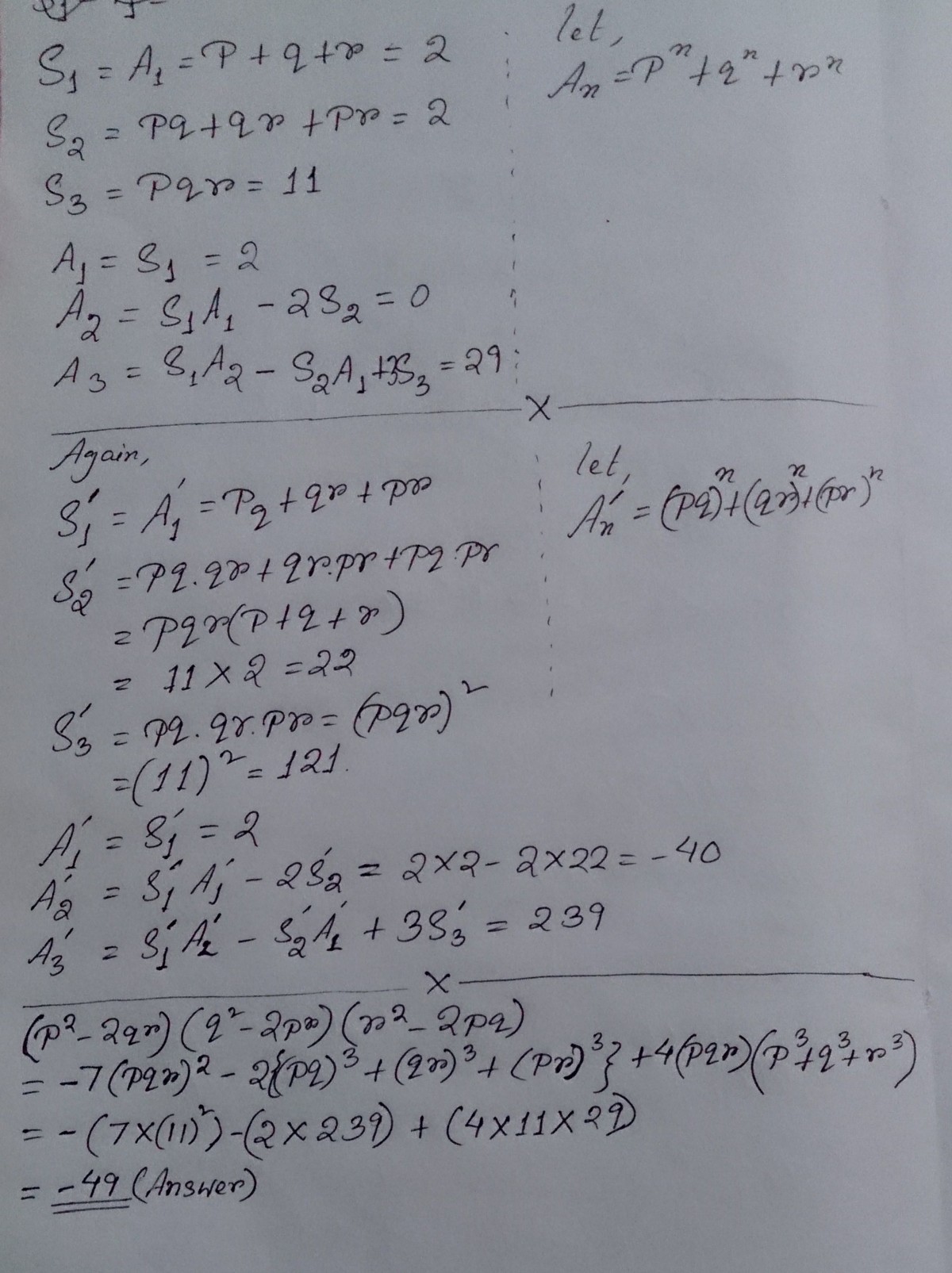Clever Manipulations 1
Let p , q , r be the roots of the equation x 3 − 2 x 2 + 2 x − 1 1 = 0 . Determine the value of the product ( p 2 − 2 q r ) ( q 2 − 2 p r ) ( r 2 − 2 p q ) .
The answer is -49.
This section requires Javascript.
You are seeing this because something didn't load right. We suggest you, (a) try
refreshing the page, (b) enabling javascript if it is disabled on your browser and,
finally, (c)
loading the
non-javascript version of this page
. We're sorry about the hassle.
5 solutions
This question freaked the hell out of me as I was getting a negative answer and I couldn't really believe that I had done a 250 pt question so fast and I spent another 20 mins just verifying the solution.
i did exactly same .... :)
did the same way!!@ @Zhou ZeHao
omg.... nice solution!!
The same way exactly....
Your solution is very nice & beautiful.. Woww!!
Since p q r = 1 1 ⇒ ( p 2 − 2 q r ) = ( p 2 − p 2 2 ) So our required expression becomes- p q r ( p 3 − 2 2 ) ( q 3 − 2 2 ) ( r 3 − 2 2 ) = 1 1 ( p 3 − 2 2 ) ( q 3 − 2 2 ) ( r 3 − 2 2 ) = 1 1 P ( s a y ) Now we need to find P . One way we can do that is to put x = ( y + 2 2 ) 3 1 so that the new cubic obtained has P as the product of its three roots- ( p 3 − 2 2 ) , ( q 3 − 2 2 ) & ( r 3 − 2 2 ) . I will directly write the new equation which is: y 3 + 3 7 y 2 + 4 1 5 y + 5 3 9 = 0 Now from here P = − 5 3 9 ⇒ 1 1 P = − 4 9
( p 2 − 2 q r ) ( q 2 − 2 p r ) ( r 2 − 2 p q )
Which give us
− 7 ( p q r ) 2 − 2 ( p 3 q 3 + q 3 r 3 + r 3 p 3 ) + 4 p q r ( p 3 + q 3 + r 3 ) . . . . . . ( i )
Now By Vieta we have
p q r = 1 1 p + q + r = 2 p q + q r + p r = 2
We know
( a + b + c ) 3 = a 3 + b 3 + c 3 + 3 [ ( a + b + c ) ( a b + b c + c a ) − a b c ]
Putting a = p , b = q a n d c = r
We get p 3 + q 3 + r 3 = 2 9
Similarly by putting
a = p q b = q r a n d c = p r
we get p q 3 + q r 3 + r p 3 = 2 3 9
now plugging all these values in . . . . ( i )
w e g e t − 7 ( 1 1 ) 2 − 2 ( 2 3 9 ) + 4 4 ( 2 9 )
⇒ − 4 9
i did it the same way too...
did same...
is it like 8+8+8+3[2 2 -11] ? bcz this is what I did but did not get 29? how to solve it correctly?
I was making mistakes using the other methods for some reason so I settled for this alternative solution using Newton's sums.

Same solution here too!
I see many have solved it but due to the enormous length of the solution, few wanna post the solution.
Thst applies for me too.
By Vieta, we have p + q + r = 2 and p q + q r + p r = 2 so p 2 + q 2 + r 2 = ( p + q + r ) 2 − 2 ( p q + p r + q r ) = 0 . So we can substitute p 2 = − q 2 − r 2 into p 2 − 2 q r to get that
p 2 − 2 q r = − q 2 − 2 q r − r 2 = − ( q + r ) 2
We also have that q + r = 2 − p so p 2 − 2 q r = − ( 2 − r ) 2 . Doing similarly for the other two, we get the desired product as
− [ ( 2 − r ) ( 2 − p ) ( 2 − q ) ] 2
Rather than expanding this, we note that x 3 − 2 x 2 + 2 x − 1 1 = ( x − p ) ( x − q ) ( x − r ) since p , q , and r are the three roots. Thus substituting x = 2 matches the expression above so
2 3 − 2 ( 2 2 ) + 2 ( 2 ) − 1 1 = − 7 = ( 2 − r ) ( 2 − p ) ( 2 − q )
so − [ ( 2 − r ) ( 2 − p ) ( 2 − q ) ] 2 = − 4 9 .